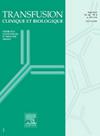保守血液注入用于体外光造血术以减少儿科患者的同种异体血液暴露。
IF 1.2
4区 医学
Q4 HEMATOLOGY
引用次数: 0
摘要
体外光移植术(ECP)是一种重要的治疗选择小儿患者免疫介导的条件。然而,ECP中涉及的高体外容量(ECV)会带来低容量血症的风险,通常需要红细胞(RBC)启动来维持血流动力学稳定性。本研究评估了一种不进行红细胞启动的儿科患者ECP保守治疗方法,旨在减少同种异体血液暴露。回顾性分析了3例ECV超过总血容量15%的儿童患者的16例ECP手术,未发现明显的不良事件或血流动力学不稳定。没有红细胞启动没有导致任何记录的并发症。这些发现表明,保守的血液启动可以安全地减少儿科ECP的异体血液暴露,潜在地减少输血相关的风险。需要进一步的研究来建立儿科人群非主要ECP期间患者选择和监测的指南。本文章由计算机程序翻译,如有差异,请以英文原文为准。
Conservative blood priming for extracorporeal photopheresis to reduce allogenic blood exposure in pediatric patients
Extracorporeal photopheresis (ECP) is a vital therapeutic option for pediatric patients with immune-mediated conditions. However, the high extracorporeal volume (ECV) involved in ECP poses a risk of hypovolemia, often necessitating red blood cell (RBC) priming to maintain hemodynamic stability. This study evaluates a conservative approach to ECP without RBC priming in pediatric patients, aiming to reduce allogenic blood exposure. A retrospective review of 16 ECP procedures across 3 pediatric patients with ECV exceeding 15% of total blood volume (TBV) found no significant adverse events or hemodynamic instability. The absence of RBC priming did not result in any documented complications. These findings suggest that conservative blood priming can safely reduce allogenic blood exposure in pediatric ECP, potentially minimizing transfusion-related risks. Further research is needed to establish guidelines for patient selection and monitoring during non-prime ECP in pediatric populations.
求助全文
通过发布文献求助,成功后即可免费获取论文全文。
去求助
来源期刊
CiteScore
2.50
自引率
11.80%
发文量
234
审稿时长
36 days
期刊介绍:
Transfusion Clinique et Biologique, the official journal of the French Society of Blood Transfusion (SFTS):
- an aid to training, at a European level
- the only French journal indexed in the hematology and immunology sections of Current Contents
Transfusion Clinique et Biologique spans fundamental research and everyday practice, with articles coming from both sides. Articles, reviews, case reports, letters to the editor and editorials are published in 4 editions a year, in French or in English, covering all scientific and medical aspects of transfusion: immunology, hematology, infectious diseases, genetics, molecular biology, etc. And finally, a convivial cross-disciplinary section on training and information offers practical updates.
Readership:
"Transfusers" are many and various: anesthetists, biologists, hematologists, and blood-bank, ICU and mobile emergency specialists...

 求助内容:
求助内容: 应助结果提醒方式:
应助结果提醒方式:


